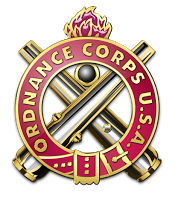1943: 331st Ordnance Battalion to
59th Ordnance Group (SASCOM)
Headquarters and Headquarters Company, 59th Ordnance Brigade was constituted in the U.S. Army in 1943 as Headquarters Detachment, 331st Ordnance Battalion and activated at Camp Livingston, Louisiana.
The following year, the battalion was reorganized and re-designated as Headquarters and Headquarters Detachment, 59th Ordnance Group. The Group served with distinction in World War II and was awarded battle credits for participation in the Central Europe Campaign and the Rhineland Campaign.
Re-designated as Headquarters and Headquarters Company, 59th Ordnance Group in 1951 the unit served in Korea and took part in five campaigns: UN Summer—Fall Offensive, Second Korean Winter, Korean Summer—Fall 1952, Third Korean Winter, and Korean Summer 1953. The Group was awarded the Meritorious Unit Citation for its outstanding service in Korea and the Group was also awarded the streamer, embroidered Korea.
In 1962, the Group was activated in Germany as Headquarters and Headquarters Company, 59th Ordnance Group (Ammunition). Later that year, it was re-designated the 59th Ordnance Group, Advanced Weapons Support Command (AWSCOM). AWSCOM and the former Special Ammunition Support Command (SASCOM) were consolidated and merged to form a "new SASCOM" in 1972. The new 59th Ordnance Group (SASCOM) moved from Frankfurt to the old SASCOM headquarters in Pirmasens. On 22 August 1977, 59th Ordnance Group (SASCOM) was re-designated as the 59th Ordnance Brigade.
1977: 59th Ordnance Brigade
The 59th Ordnance Brigade was composed of 8 battalion—sized units: 2 ordnance battalions, 5 artillery groups, and a headquarters support battalion. Consisting of more than 6,500 personnel, Brigade units were located in 35 cities and towns throughout the Federal Republic of Germany and the Netherlands. The ordnance battalions supported U.S. units, while the artillery groups supported the NATO countries of the Federal Republic of Germany, the United Kingdom, Belgium, and the Netherlands, exercising interoperability on a daily basis to accomplish the common mission. The 59th Ordnance Brigade combined two missions, the ordnance and the artillery, and performed a mission that was the backbone of the NATO alliance.
Brigade units had histories spanning 3 conflicts and 20 campaigns. Units of the Brigade also earned 35 unit decorations and 177 campaign credits. Two units hit the beach in Sicily and one was a participant in the D-Day landings in Normandy. In Korea, one company took part in the Inchon landings, and still others saw service in Vietnam.
The 59th Ordnance Brigade once served as an integral part of the United States' commitment to her NATO friends, and the Brigade was one of the major deterrent forces within the NATO alliance.
On 15 October 1992, the brigade was officially deactivated according to Headquarters, U.S. Army, Europe, and Seventh Army Permanent Orders 129-3. It officially reactivated, however, on 1 October 1994 at Redstone Arsenal,when it merged with the U.S. Army Ordnance Missile and Munitions Center and School (USAOMMCS) to become the U.S. Army Ordnance Missile and Munitions Center and School/59th Ordnance Brigade. Subsequently, the commandant of USAOMMCS also became the brigade commander, who oversaw those functions assigned to the brigade accordingly. The school was renamed the U.S. Army Ordnance Munitions and Electronic Maintenance School/59th Ordnance Brigade on 3 October 2002.


